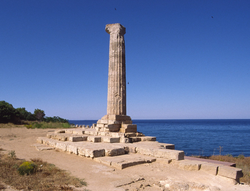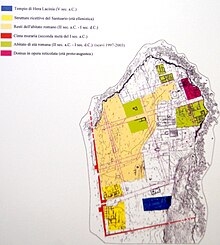166:
61:
77:
373:) with a serving counter in calcarenite. The domus was entered via a large atrium, in the first phase Tuscan (i.e. without columns), and then tetrastyle (i.e. with four columns supporting the roof to collect rainwater). After abandonment and ruin at the beginning of the 2nd century AD, some of its rooms were rebuilt between the end of the 2nd and the beginning of the 3rd century with a pottery kiln for terracotta artefacts.
251:
578:
267:
259:
84:
319:
From the second half of the 2nd century BC, town house construction increased which occupied a good part of the sectors between the central plateau and the northern edge of the cliff. Near the NE cliff two houses belonging to rich local people arose from the end of the 2nd century BC. The domus "DR"
288:
Cn. Octavius, L. Aemilius Paulus, C. Laetorius. The occupation was not limited to the settlement at Capo
Lacinio as excavations have shown that the agricultural hinterland was occupied by at least 91 rural farms of various sizes and periods, presumably on land distributed to the settlers after 194
363:) and a furnace (praefurnium) were built to heat the water for the hot bath (solium) in a large room on whose floor is a mosaic with geometric motifs (meandering 3D polychrome swastikas, a wave motif) framing a central rhomboidal checkerboard with four dolphins at the corners.
389:
A public L-shaped portico forming a public square or forum, aligned with the adjacent domus, is from the
Augustan age. A major complex with an imposing monumental fountain near the sanctuary also dates from the late 1st century BC lasting until the 3rd/4th century AD.
315:
The settlement eventually occupied the entire northern end of the promontory and was organised with a rectangular street plan with three main streets oriented east-weast and avoiding the
Sanctuary of Hera and its immediate surroundings on a different alignment.
412:
Even after the abandonment of the town, the continuation of devotion to Hera
Lacinia is still attested between 98 and 105 AD from an altar dedicated by Oecius imperial procurator (libertus procurator), in favour of Ulpia Marciana, sister of Trajan.
366:
The later domus "CRr" (last 30 years of the 1st century BC) is exceptional both for its building techniques and its area of over 2100 m. The entrance portico provided a sheltered public area for shops including a room for the sale of drinks (a
506:
FAUSTO ZEVI, Kroton. Studi e ricerche sulla polis achea e il suo territorio (Atti e
Memorie della Società Magna Grecia, s. IV, vol. V, 2011-2013) a cura di Roberto Spadea, Roma, Giorgio Bretschneider Editore,
486:
289:
BC, and with occupation continuing to the late empire. Colonies usually received 300 men, generally veterans, each who would be assigned from 1 to 2.5 hectares of agricultural land from the
320:
is the oldest (end of the 2nd century BC, of about 15 x 34 m) and had a residential part around the atrium and a sector for service and production which overlooked a courtyard. The
238:
The Cape became an ancient Greek sanctuary to Hera in the 7th c. BC and one of the most important sanctuaries of Magna
Graecia. It was closely linked to the ancient Greek colony of
474:
487:
https://www.perseus.tufts.edu/hopper/text?doc=Perseus:text:1999.04.0064:entry=croton-geo&toc=Perseus%3Atext%3A1999.04.0064%3Aalphabetic+letter%3DS%3Aentry+group%3D12
593:
60:
598:
382:
with a rectanglar plan were reconstructed probably after the pirate raids of the second and third quarter of the 1st century BC and after the siege of
308:, as prefect of the Roman fleet, inspected the ships coming from the Tyrrhenian and Ionian seas there before they set off towards the Aegean against
108:
636:
438:) are visible on the cape. The temple was said to have still been fairly complete in the 16th century, but was destroyed to build the
631:
76:
427:
233:
165:
393:
The decline and progressive abandonment of the town of
Lacinium probably began after the Augustan era. The settlement became a
626:
555:
Clara
Stevanato, Senators and memory in the funerary epigraphy of Roman Italy (1st century BC-3rd century AD), 2020, p. 95
546:
Salvatore
Medaglia, Carta archeologica della provincia di Crotone, Università della Calabria 2010 ISBN 978-88-903625-4-5
301:(common state land) for pasture and woodland. With their families, around 1500 Roman citizens in total can be assumed.
616:
357:
Lucilius Macer and
Annaeus Trasus in 80-70 BC, as attested by an inscription on the mosaic. A circular sweating room (
221:
The entire peninsula is now within the Capo Colonna Archaeological Park and a museum nearby houses important finds.
297:
337:). Between the end of the 2nd and beginning of the 1st century BC the building was remodeled and enlarged in
455:
201:
534:
Giuseppe Celsi, La colonia romana di Croto e la statio di Lacenium, Gruppo Archeologico Krotoniate (GAK)
30:
This article is about location in Italy. For the location in Greece formerly called Capo Colonne, see
291:
535:
211:
The peninsula was the site of a great sanctuary of Hera from the 7th c. BC, the most famous in
621:
435:
378:
275:
185:
51:
383:
279:
329:
The baths were originally built for another public function (the first two phases are in
610:
589:
584:
406:
339:
309:
212:
17:
304:
The maritime role of the colony of Lacinium was highlighted as early as 190 BC when
208:). The modern name derives from the remaining column of the Temple of Hera Lacinia.
443:
250:
485:
William Smith, CROTON or CROTONA, Dictionary of Greek and Roman Geography (1854)
475:
Harry Thurston Peck, Harpers Dictionary of Classical Antiquities (1898), Lacinium
386:
in 36 BC. The sanctuary was renovated soon afterwards, as shown by tile stamps.
266:
258:
157:
123:
110:
359:
284:
353:
322:
189:
143:
602:. Vol. 15 (11th ed.). Cambridge University Press. p. 50.
369:
239:
193:
31:
218:
Later the Romans built the fortified town of Lacinium over the area.
439:
401:
395:
224:
Excavations from 2014 have greatly increased knowledge of the site.
583:
This article incorporates text from a publication now in the
348:
265:
257:
249:
164:
147:
516:
C.G.Severino, Crotone. Da polis a città di Calabria, 1988, p. 29
431:
305:
536:
https://www.gruppoarcheologicokr.it/la-colonia-romana-di-croto/
65:
The last column of the Temple dedicated to Hera (Juno) Lacinia.
326:
has a mosaic floor with animals (ducks, dolphins, fish).
409:, and more and more concentrated around the sanctuary.
570:
Die griechischen Tempel in Unteritalien und Sicilien
446:
with capital, about 27 feet (8.2 m) in height.
196:. In ancient Roman times the promontory was called
153:
139:
39:
442:palace at Crotone. The remaining feature is a
8:
36:
295:(state land), as well as free use of the
467:
138:
69:
57:
169:Lacinium in the Roman period (c. 0 AD)
152:
7:
83:
568:See R. Koldewey and O. Puchstein,
25:
576:
234:Temple of Juno Lacinia (Crotone)
82:
75:
59:
637:Roman towns and cities in Italy
278:the Romans created a maritime
1:
405:marked as "Licenium" on the
343:to create a bath complex or
298:ager compascus scripturarius
246:The Roman colony of Lacinium
653:
231:
205:
29:
422:Sanctuary of Hera Lacinia
104:
70:
58:
49:
632:Temples in Magna Graecia
599:Encyclopædia Britannica
456:Capo Colonne Lighthouse
376:The defensive walls in
282:here, entrusted to the
27:Cape in Calabria, Italy
594:Lacinium, Promunturium
271:
263:
255:
170:
627:Landforms of Calabria
269:
261:
253:
198:Promunturium Lacinium
168:
154:Offshore water bodies
124:39.02944°N 17.20500°E
44:Promunturium Lacinium
18:Promunturium Lacinium
428:Ancient Greek temple
274:In 194 BC after the
525:Livy,XXXVI, 42, 1-4
497:Livy Book XXXIV; 45
120: /
617:Headlands of Italy
572:(Berlin 1899, 41).
272:
264:
256:
182:Capo della Colonne
171:
129:39.02944; 17.20500
270:Baths of Lacinium
262:Walls of Lacinium
163:
162:
96:Location in Italy
16:(Redirected from
644:
603:
582:
580:
579:
556:
553:
547:
544:
538:
532:
526:
523:
517:
514:
508:
504:
498:
495:
489:
483:
477:
472:
426:The ruins of an
379:opus reticulatum
276:Second Punic War
254:Plan of Lacinium
207:
135:
134:
132:
131:
130:
125:
121:
118:
117:
116:
113:
86:
85:
79:
63:
37:
21:
652:
651:
647:
646:
645:
643:
642:
641:
607:
606:
592:, ed. (1911). "
588:
577:
575:
565:
560:
559:
554:
550:
545:
541:
533:
529:
524:
520:
515:
511:
505:
501:
496:
492:
484:
480:
473:
469:
464:
452:
424:
419:
384:Sextus Pompeius
248:
236:
230:
128:
126:
122:
119:
114:
111:
109:
107:
106:
100:
99:
98:
97:
94:
93:
92:
91:
87:
66:
54:
45:
42:
35:
28:
23:
22:
15:
12:
11:
5:
650:
648:
640:
639:
634:
629:
624:
619:
609:
608:
605:
604:
590:Chisholm, Hugh
573:
564:
561:
558:
557:
548:
539:
527:
518:
509:
499:
490:
478:
466:
465:
463:
460:
459:
458:
451:
448:
423:
420:
418:
415:
335:opus implectum
331:opus quadratum
292:ager colonicus
247:
244:
232:Main article:
229:
226:
206:Λακίνιον ἄκρον
161:
160:
155:
151:
150:
141:
137:
136:
102:
101:
95:
89:
88:
81:
80:
74:
73:
72:
71:
68:
67:
64:
56:
55:
50:
47:
46:
43:
40:
26:
24:
14:
13:
10:
9:
6:
4:
3:
2:
649:
638:
635:
633:
630:
628:
625:
623:
620:
618:
615:
614:
612:
601:
600:
595:
591:
586:
585:public domain
574:
571:
567:
566:
562:
552:
549:
543:
540:
537:
531:
528:
522:
519:
513:
510:
503:
500:
494:
491:
488:
482:
479:
476:
471:
468:
461:
457:
454:
453:
449:
447:
445:
441:
437:
433:
430:dedicated to
429:
421:
416:
414:
410:
408:
407:Peutinger Map
404:
403:
398:
397:
391:
387:
385:
381:
380:
374:
372:
371:
364:
362:
361:
356:
355:
351:era), by the
350:
346:
342:
341:
340:opus incertum
336:
332:
327:
325:
324:
317:
313:
311:
310:Antiochus III
307:
302:
300:
299:
294:
293:
287:
286:
281:
277:
268:
260:
252:
245:
243:
241:
235:
227:
225:
222:
219:
216:
214:
213:Magna Graecia
209:
203:
202:Ancient Greek
199:
195:
192:located near
191:
187:
183:
179:
175:
167:
159:
156:
149:
145:
142:
133:
105:Coordinates:
103:
78:
62:
53:
48:
38:
33:
19:
597:
569:
563:Bibliography
551:
542:
530:
521:
512:
502:
493:
481:
470:
444:Doric column
425:
411:
400:
394:
392:
388:
377:
375:
368:
365:
358:
352:
347:(III phase,
344:
338:
334:
330:
328:
321:
318:
314:
303:
296:
290:
283:
273:
237:
223:
220:
217:
210:
197:
181:
178:Capo Colonne
177:
174:Capo Colonna
173:
172:
90:Capo Colonna
41:Capo Colonna
176:(sometimes
127: /
611:Categories
462:References
158:Ionian Sea
115:17°12′18″E
112:39°01′46″N
440:episcopal
360:laconicum
285:triumvirs
450:See also
354:duumvirs
323:tablinum
242:nearby.
190:Calabria
144:Calabria
140:Location
622:Crotone
587::
370:caupona
345:balneum
228:History
194:Crotone
184:) is a
32:Sounion
581:
417:Sights
402:statio
396:mansio
349:Sullan
280:colony
240:Kroton
148:Italy
507:2014
436:Juno
432:Hera
333:and
306:Livy
186:cape
52:Cape
596:".
399:or
188:in
180:or
613::
312:.
215:.
204::
146:,
434:(
200:(
34:.
20:)
Text is available under the Creative Commons Attribution-ShareAlike License. Additional terms may apply.





